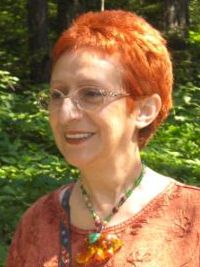Julia Tsenova facts for kids
Quick facts for kids
Julia Tsenova
|
|
|---|---|

Prof. Julia Tsenova in 2008
|
|
| Background information | |
| Born | July 30, 1948 Sofia, Bulgaria |
| Died | 11 April 2010 (aged 61) |
| Occupation(s) | Composer, Pianist |
Julia Tsenova (born July 30, 1948 – died April 11, 2010) was an amazing Bulgarian composer, pianist, and music teacher. She was born in Sofia, Bulgaria, and won many awards for her music.
Contents
Life and Career of Julia Tsenova
Julia Tsenova studied both composition and piano at the State Academy of Music in Sofia. She learned from a famous teacher named Prof. Pancho Vladigerov.
She also took part in special classes for composers in Sofia and Amsterdam. These classes were led by Prof. Ton de Leeuw from the Netherlands. Julia Tsenova attended many music workshops across Europe.
Her music was played at different modern music festivals. It was also featured at the International Composers' Rostrum in Paris in 1995.
Starting in 1997, she became a Professor of Piano. She was also the Dean of the Pop and Jazz Music Faculty at the State Academy of Music. Julia Tsenova was a member of the Union of the Bulgarian Composers. She was also president of the Bulgarian section of the International Society for Contemporary Music.
Julia Tsenova passed away on April 11, 2010. Her daughter, Kristina Sandulova, is also a talented concert pianist.
Julia Tsenova's Musical Style
Julia Tsenova had many different musical interests. She wrote music for orchestras (symphonic), small groups of instruments (chamber), choirs (choral), and even for plays or movies (scenic music).
Her pieces were often very dramatic and full of strong feelings. They also explored deep ideas and philosophies. As a composer, she had a unique style. She was very skilled at using modern ways to create music.
Tsenova was always interested in old eastern philosophies. These ideas often found their way into her creative works. You can see hints of this in her later music too.
Her compositions were performed in many countries. These include Bulgaria, Austria, England, Germany, France, Italy, Netherlands, Norway, Poland, Czech Republic, Slovakia, Hungary, Russia, and the United States. Her music was also heard in Canada, Australia, India, and other places.
Personal Details and Legacy
In 2002, the Bulgarian National Television made a documentary about Julia Tsenova. It was called Prayers onto the Wall and showed her life and works.
She passed away on April 11, 2010, in Sofia. She is buried in the Central Sofia Cemetery.
Selected Works by Julia Tsenova
Here are some of the musical pieces Julia Tsenova created:
Symphonic Music
These are pieces written for a large orchestra.
- 1974 Sinfonia con piano concertante
- 1979 Movement for orchestra
- 1984 Fest music - for orchestra
- 1994 Fresco - for chamber choir and orchestra
- 2000 Suggestion - for orchestra
- 2001 Shopp Dance
Chamber Music
These pieces are for smaller groups of instruments or solo performers.
- 1973 Three Indian songs - for a solo contralto singer
- 1975 Seven songs - for soprano voice and string quintet
- 1976 Three Frescoes with Epilogue for viola and piano
- 1981 Step and Rag-Time for viola and piano
- 1985 Music for the mice - for Flute, Clarinet, Bassoon
- 1986 Music in the entr'acte - for Piano, Viola, Contrabass, with tape effects
- 1987 Cantus Firmus a due - for Clarinet, Piano, Marimba
- 1990 Diving in the poles - for seven voices (4+3)
- 1993 The water sends me to sleep - for Piano, Clarinet, Vibraphone, and sound effects
- 1995 The endless circle - for Piano, String quintet, Flute, French Horn
- 1996 Temptation - a chamber opera (a small musical play)
- 1996 Triptych for Keyboard - for Piano
- 1996 ...Invoking the gods - for Altoflute, Mexican sistrum, Piano, Mexican drum, Contrabass, and log drum
- 1997 Musica solitudinis - for Piano
- 1997 A swan song - for a female folk choir
- 1997 An album of jazz pieces for piano
- 1998 Shop dance - a piece for piano, played by four hands
- 1998 = 3.14 - for voice and chamber orchestra
- 1998 Isida's unveiling - for alto saxophone, easy piano, trumpet, and audio amplifier with loudspeaker system
- 1999 Four prayers - for Piano
- 2000 Green silence - for Flute, Viola, Harp, and Piano
- 2001 The seventh door - for Flute, Clarinet, Violin, Cello, Piano
- 2001 A Song Cycle - for Soprano and Piano (based on poems by Ingeborg Bachmann)
- 2002 Quantum Satis - for female folk choir, 2 Pianos, Gong, and cassa drum
- 2002 Temple of the Dancers - for 3 Flutes (1 solo + 2 others)
- 2003 Metamorphoses - for piano, played by four hands
- 2003 String Quartet
- 2003 Curriculum Vitae - for soprano and piano (based on I. Bachmann's work)
- 2004 The Left Dragon - for solo oboe
Images for kids



